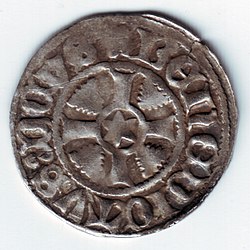Witte (coin)
Witte (also Witten, Wittenpfennig, Veerling) was the name for a coin minted on both sides with a value of four pfennigs. The coin received this colloquial name because of its white (“witte”) appearance, which was created by the white brew . In documents, the Witte was called "penningh van veer penninghen". In Denmark-Norway the coin was called "Hvide".
The Witten were minted in the northern German cities of Hamburg and Wismar after 1330, starting from Lübeck . This was followed by the cities of Lüneburg , Rostock and Stralsund , which agreed in different compositions in recesses within the Wendish Mint Association on the appearance, weight and fineness of the Witten. Outside of the Wendish Münzverein, Witten emerged in cities in Pomerania and Holstein .
In the course of the 15th century the witte was replaced by other denominations, the Dreiling , Sechsling , Schilling and Doppelschilling . Only once again, and then only for a short time, was the Witte minted in the Wendish Mint Association at the beginning of the 16th century. These witches were imitated in the county of Hoya , in Diepholz and Rietberg , in the diocese of Verden and in Stade .

